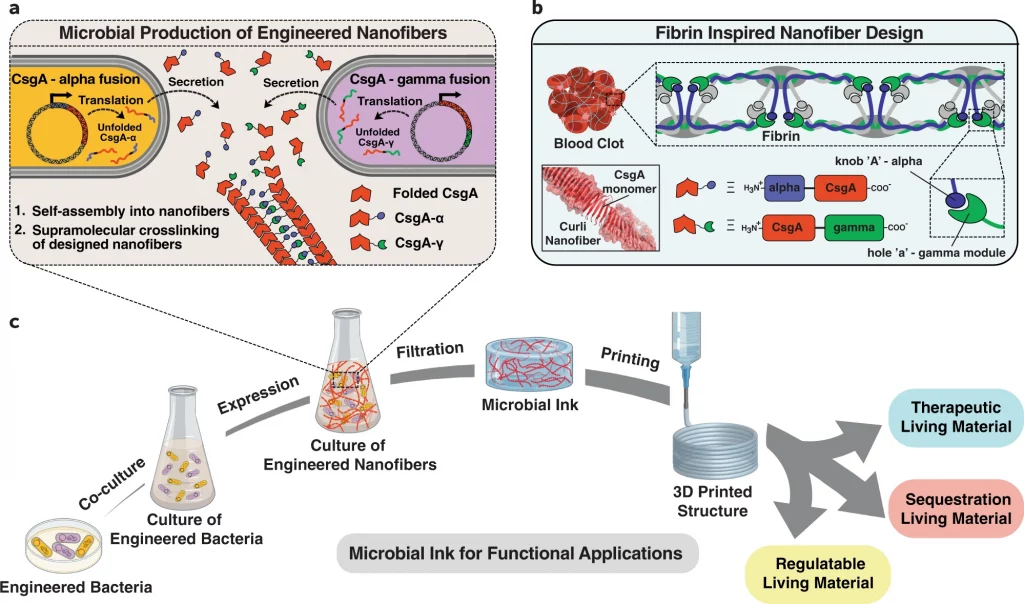Researchers from the Massachusetts Institute of Technology (MIT), Northwestern University, and other institutions have, for the first time, bioprinted living structures without the use of any polymers aside from the biological material itself. The items produced were created with a gel made up of protein polymer molecules generated by E-coli. The goal was to design devices that release anti-cancer drugs or capture toxins from the environment.
“This is the first of its kind… a living ink that can respond to the environment. We have repurposed the matrix that these bacteria normally utilise as a shielding material to form a bio-ink,” said MIT research affiliate Avinash Manjula-Basavanna, whose research was published in Nature Communications.

“a E. coli was genetically engineered to produce microbial ink by fusing α (knob) and γ (hole) protein domains, derived from fibrin to the main structural component of curli nanofibers, CsgA. Upon secretion, the CsgA-α and CsgA-γ monomers self-assemble into nanofibers crosslinked by the knob-hole binding interaction. b The knob and hole domains are derived from fibrin, where they play a key role in supramolecular polymerization during blood clot formation. c The protocol to produce microbial ink from the engineered protein nanofibers involves standard bacterial culture, limited processing steps, and no addition of exogenous polymers. Microbial ink was 3D printed to obtain functional living materials.” Image courtesy of Nature Communications.
E.coli cells were first genetically engineered to produce protein polymer molecules called curli nanofibers, which had one of two oppositely charged modules attached them, either “knobs” or “holes”. As the curli fibers were produced, they would crosslink, with the knobs from one locking into the holes of another. This material was then filtered through a nylon membrane before the E.coli cells were removed, resulting in a gel viscous and elastic enough that it could be printed.
Deposited from a nozzle, the researchers were able to produce fibers as fine as a half-a-millimeter wide. They were then able to maintain strength while being stretched between two columns separated by 16 mm of space.
“Our group has always been interested in engineering biology to make materials,” Northeastern University chemist and study co-author Neel Joshi told The Daily Beast. “In the same way that a seed has a set of genetic instructions to produce a tree, we want to provide biological cells with a set of genetic instructions that program them to make material structures with prescribed properties.”

Single-layer grid, 10-layer square, 10-layer circle, and 21-layer solid cone. Scale bar 1 mm. Image courtesy of Nature Communications.
To take the project further, the team embedded a new type of E.coli engineered to either release the anti-cancer drug azurin. When exposed to a chemical called IPTG, the azurin-seeded structures could release the medicine on demand. They also created a variety of E.coli capable of producing curli fibers that could bind to bisphenol A (BPA), the toxic material found in many plastics. This allowed the gel to absorb almost 30 percent of the toxin from a surrounding liquid in just 24 hours.
“I remember that moment when it bridged this gap and I was screaming and jumping,” Manjula-Basavanna said. The team has not yet determined the lifespan of the 3D printed structures, but have demonstrated the ability of other types of living geometries to remain stable for over two years.
Though I’m struggling to find published evidence of it now, I suggested once that, in the future, we could see bioprinting used to create living structures on a large scale. It seems that this is exactly what the team has in mind, including in construction. The authors note:
Especially if combined with other materials technologies, such as those that are already incorporating living cells into structural building materials, our microbial bioink could also be particularly useful for structure building in space or extraterrestrial habitats, where raw material transport is difficult, making on-demand generation of building materials from very limited resources essential.
That day is still surely a long way off, but these are the exact types of approaches we need to be considering when it comes to applying technology to mitigating ecosystem collapse. It isn’t enough to 3D print more efficient jet engines. We need to repair the damage that has already been done and learn to live in equilibrium with the planet.
Subscribe to Our Email Newsletter
Stay up-to-date on all the latest news from the 3D printing industry and receive information and offers from third party vendors.
You May Also Like
New Report: Semiconductor Industry to See $1.4B in 3D Printing Revenues by 2032
“The semiconductor sector has become the most strategically significant area of global industry.” Truer words are hard to come by when it comes to the modern world, and they are...
Will Photonic-Crystal Lasers Revolutionize 3D Printing?
Powder bed fusion (PBF) for metals and polymers predominantly utilizes lasers as the primary heat source. Some directed energy deposition (DED) technologies also employ lasers, while various vat polymerization methods...
3D Printing Unpeeled: Orbex Investment, IndoMIM and HP, Ultrasonic Waves
INDO-MIM has bought three HP Metal Jet S100 printers, operating two in India and one in Texas. This is a win for HP because the company has deep experience in...
3D Printing Webinar and Event Roundup: April 21, 2024
It’s another busy week of webinars and events, starting with Hannover Messe in Germany and continuing with Metalcasting Congress, Chinaplas, TechBlick’s Innovation Festival, and more. Stratasys continues its advanced training...































